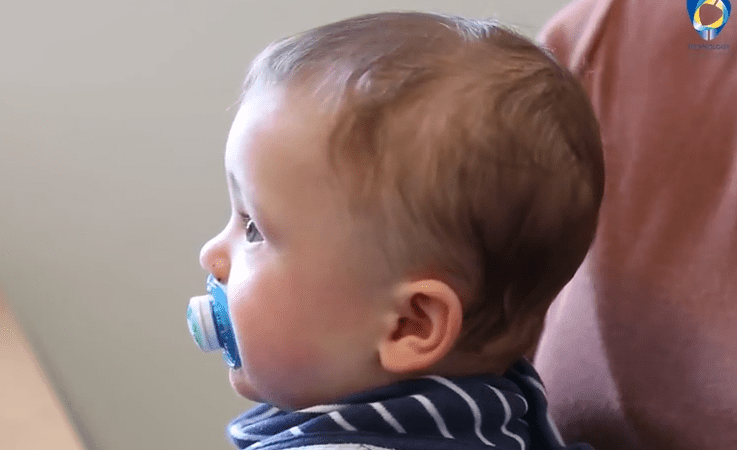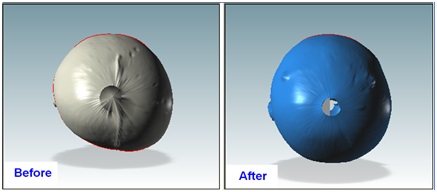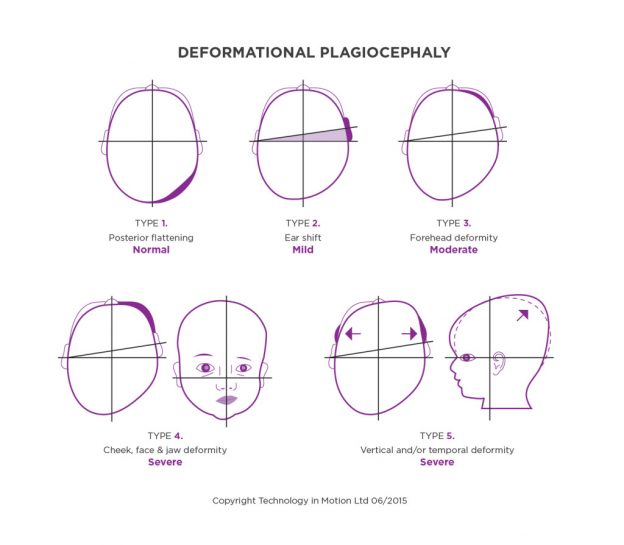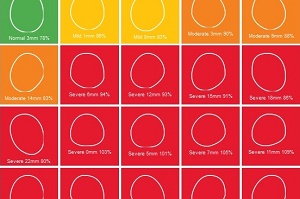

What Do I Look For?

Positional plagiocephaly can be easily assessed by looking down on the top of the head from above.
Normal head shape
The head looks evenly round on both sides and at the back. The head looks a little like an egg shape. There might be a slight difference between the right and left sides at the back.
Mild plagiocephaly
There is a slight flattening to one side of the back of the head and the ear on the flattened side might be pushed forward a little.
Moderate plagiocephaly
There is a flattening on one side at the back, the ear on the same side is pushed forwards. The brow and the cheek on the same side is also pushed forward.
Severe plagiocephaly
There is flattening on one side at the back, the ear, the brow and the cheek is pushed forward on the same side. The side of the cheek is more round on the same side and one eye is more open than the other. The non-flattened side may be pushed away from the midline and this side is much more rounded than the flattened side.
During your baby’s first year, it is important to keep an eye on the shape of their head, because early identification invariably leads to more successful treatment.
If you are unsure whether your child is suffering from positional plagiocephaly, contact us today and book your no-obligation assessment.
Why Does This Happen?
Research shows that half of new-born babies show some signs of plagiocephaly and that many self-correct. However, one in twenty five babies go on to develop a significant plagiocephaly. As its name suggests, positional plagiocephaly is a deformity of the skull which is mainly caused by a baby lying with the head in one position for too long during the early stages of infancy. As babies cannot support themselves during the first few months of life, they tend to lie on their backs and develop a positional preference (a position in which they feel the most comfortable). When a child lies in the same position for long periods of time, the skull can begin to deform and flatten.
Although this is how positional plagiocephaly commonly develops, there are other factors which can influence and encourage skull flattening:
Premature birth:
Children born before their full term have not had chance to fully develop their skeletal structures, so their skulls are soft and can become deformed.
Twins:
There is only a limited space in the womb. When pregnant with twins, this space has to be shared between two children, thus increasing the chance of pre-birth pressure on the skull. It is fairly common for babies within multiple births to develop flattened areas on the skull during development.
Assisted birth:
If the mother is having problems and there is a forceps or ventouse (vacuum) assisted birth, there can be bruising to the skull or neck and shoulder muscles. These can restrict neck and head movement which can lead to the baby developing a plagiocephaly.
The Different Types of Head Shape
In other blog posts we have highlighted the key differences between plagiocephaly and brachycephaly and have explored how to differentiate between plagiocephaly and craniosyntosis. However, it is also important for the clinician to understand how plagiocephaly differs from other forms of flat head syndrome to ensure that the correct specialist treatment is prescribed.
Prevention
Infants with plagiocephaly can have a head shape deformity which is on the scale from mild to severe. For effective treatment, early intervention is essential with a small window of opportunity to help. Once a child reaches the age of 14 months, there is too little growth available and the skull structures are too rigid to be moulded back into shape. The ideal age to seek treatment is between 4-9 months.

Mild forms of positional plagiocephaly are regularly corrected using repositioning techniques such as ‘tummy time’: for advice on how to reposition your baby, check out our repositioning guide. However, if your child has a moderate to severe level of plagiocephaly, a specially crafted plagiocephaly helmet may be prescribed. Helmet therapy works by relieving pressure from the flattened part of the skull, gently encouraging it to grow naturally to a more normal, rounded shape.
If your family are about to embark on a plagiocephaly journey, you are not alone: read parent’s stories and explore the best places to get plagiocephaly advice and support such as children’s fundraising charity headstart4babies and Tree of Hope.


